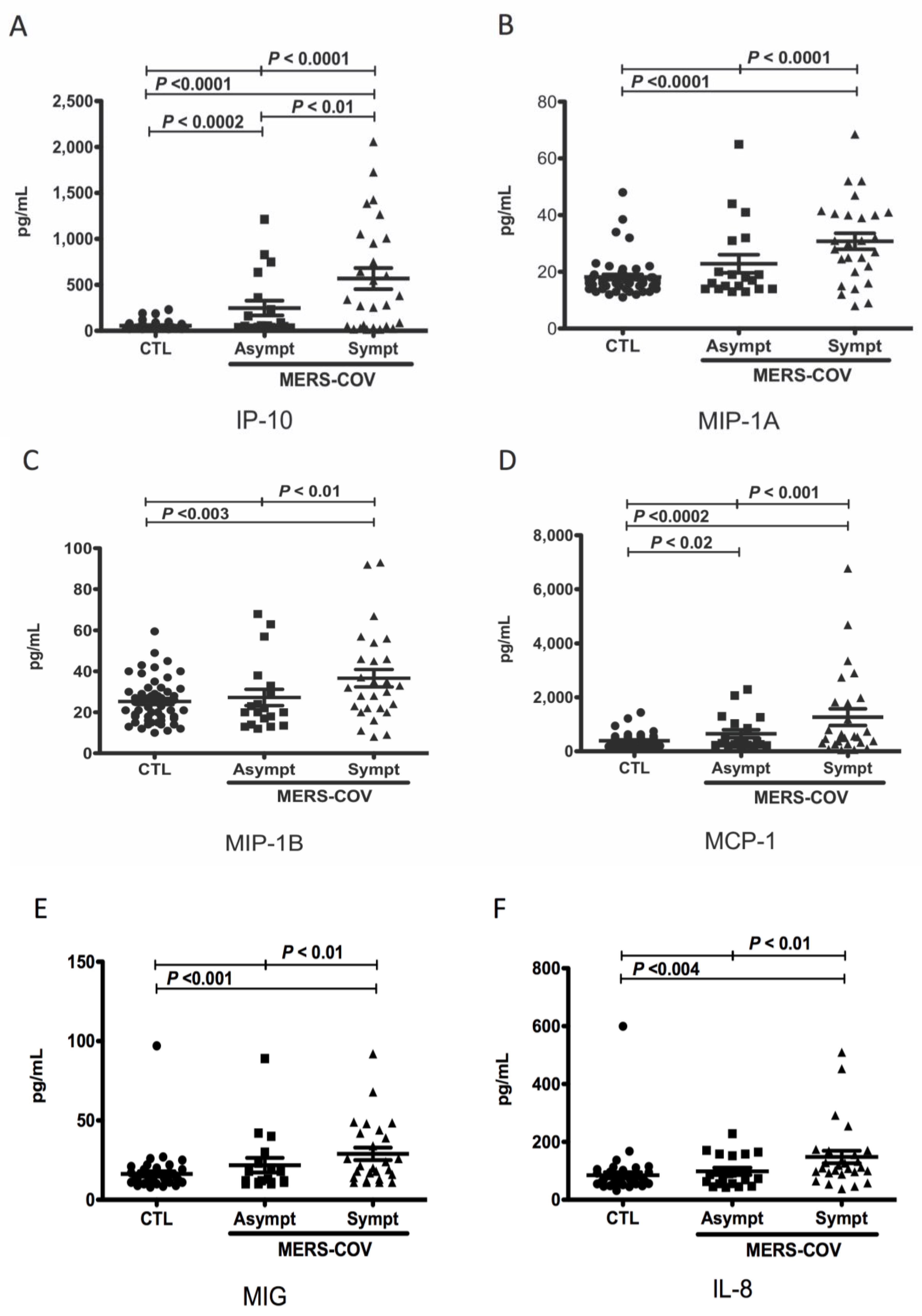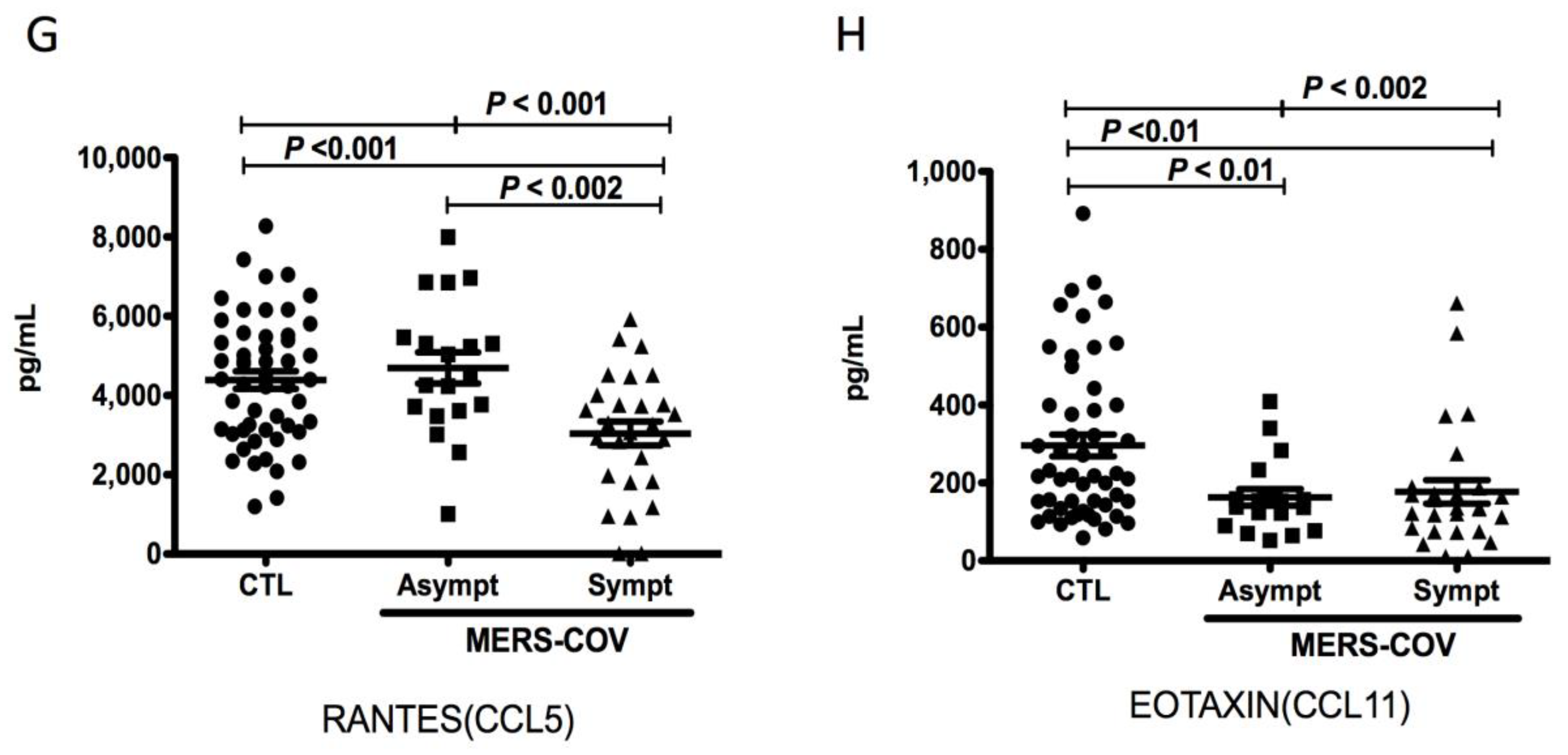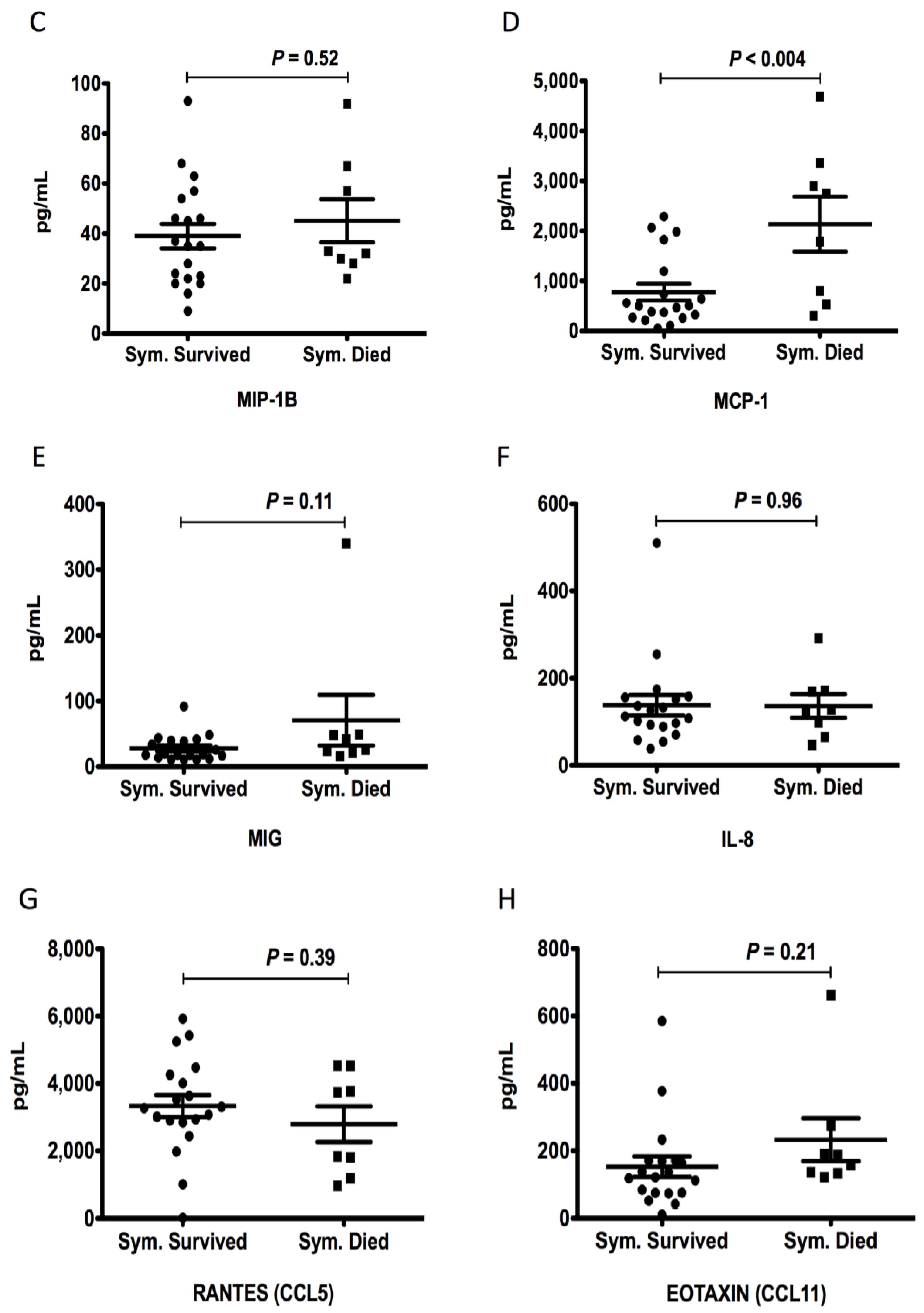Chemokine Levels among Patients with Middle East Respiratory Syndrome Coronavirus Infection
Abstract
:1. Introduction
2. Subjects and Methods
2.1. Measurement of Chemokine Levels Using Luminex Human Chemokine Magnetic Multiplex Panel
2.2. Diagnosis of MERS-CoV Infection Using a Qualitative Real-Time Reverse Transcription-Polymerase Chain Reaction (RT-PCR)
2.3. Statistical Analysis
3. Results
4. Discussion
5. Conclusions
Author Contributions
Funding
Institutional Review Board Statement
Informed Consent Statement
Data Availability Statement
Acknowledgments
Conflicts of Interest
References
- Mackay, I.M.; Arden, K.E. MERS coronavirus: Diagnostics, epidemiology and transmission. Virol. J. 2015, 12, 222. [Google Scholar] [CrossRef] [PubMed]
- World Health Organization. Middle East Respiratory Syndrome: Global Summary and Assessment of Risk, 16 November 2022. Available online: https://www.who.int/publications/i/item/WHO-MERS-RA-2022.1. (accessed on 25 May 2023).
- Akdis, M.; Burgler, S.; Crameri, R.; Eiwegger, T.; Fujita, H.; Gomez, E.; Klunker, S.; Meyer, N.; O’Mahony, L.; Palomares, O.; et al. Interleukins, from 1 to 37, and interferon-gamma: Receptors, functions, and roles in diseases. J. Allergy Clin. Immunol. 2011, 127, 701–721.e70. [Google Scholar] [CrossRef] [PubMed]
- Palomino, D.C.; Marti, L.C. Chemokines and immunity. Einstein 2015, 13, 469–473. [Google Scholar] [CrossRef]
- Zlotnik, A.; Yoshie, O. Chemokines: A new classification system and their role in immunity. Immunity 2000, 12, 121–127. [Google Scholar] [CrossRef] [PubMed]
- Mahdavian Delavary, B.; van der Veer, W.M.; van Egmond, M.; Niessen, F.B.; Beelen, R.H. Macrophages in skin injury and repair. Immunobiology 2011, 216, 753–762. [Google Scholar] [CrossRef] [PubMed]
- Tsirogianni, A.K.; Moutsopoulos, N.M.; Moutsopoulos, H.M. Wound healing: Immunological aspects. Injury 2006, 37 (Suppl. 1), S5–S12. [Google Scholar] [CrossRef]
- Glass, W.G.; Rosenberg, H.F.; Murphy, P.M. Chemokine regulation of inflammation during acute viral infection. Curr. Opin. Allergy Clin. Immunol. 2003, 3, 467–473. [Google Scholar] [CrossRef]
- Khalil, B.A.; Elemam, N.M.; Maghazachi, A.A. Chemokines and chemokine receptors during COVID-19 infection. Comput. Struct. Biotechnol. J. 2021, 19, 976–988. [Google Scholar] [CrossRef]
- Choudhry, H.; Bakhrebah, M.A.; Abdulaal, W.H.; Zamzami, M.A.; Baothman, O.A.; Hassan, M.A.; Zeyadi, M.; Helmi, N.; Alzahrani, F.; Ali, A.; et al. Middle East respiratory syndrome: Pathogenesis and therapeutic developments. Future Virol. 2019, 14, 237–246. [Google Scholar] [CrossRef]
- Zhou, J.; Chu, H.; Li, C.; Wong, B.H.; Cheng, Z.S.; Poon, V.K.; Sun, T.; Lau, C.C.; Wong, K.K.; Chan, J.Y.; et al. Active replication of Middle East respiratory syndrome coronavirus and aberrant induction of inflammatory cytokines and chemokines in human macrophages: Implications for pathogenesis. J. Infect. Dis. 2014, 209, 1331–1342. [Google Scholar] [CrossRef]
- Lau, S.K.P.; Lau, C.C.Y.; Chan, K.H.; Li, C.P.Y.; Chen, H.; Jin, D.Y.; Chan, J.F.W.; Woo, P.C.Y.; Yuen, K.Y. Delayed induction of proinflammatory cytokines and suppression of innate antiviral response by the novel Middle East respiratory syndrome coronavirus: Implications for pathogenesis and treatment. J. Gen. Virol. 2013, 94, 2679–2690. [Google Scholar] [CrossRef] [PubMed]
- Zhou, J.; Chu, H.; Chan, J.F.; Yuen, K.Y. Middle East respiratory syndrome coronavirus infection: Virus-host cell interactions and implications on pathogenesis. Virol. J. 2015, 12, 218. [Google Scholar] [CrossRef] [PubMed]
- Jamilloux, Y.; Henry, T.; Belot, A.; Viel, S.; Fauter, M.; El Jammal, T.; Walzer, T.; Francois, B.; Seve, P. Should we stimulate or suppress immune responses in COVID-19? Cytokine and anti-cytokine interventions. Autoimmun. Rev. 2020, 19, 102567. [Google Scholar] [CrossRef] [PubMed]
- Liao, M.; Liu, Y.; Yuan, J.; Wen, Y.; Xu, G.; Zhao, J.; Cheng, L.; Li, J.; Wang, X.; Wang, F.; et al. Single-cell landscape of bronchoalveolar immune cells in patients with COVID-19. Nat. Med. 2020, 26, 842–844. [Google Scholar] [CrossRef]
- Hu, W.; Yen, Y.T.; Singh, S.; Kao, C.L.; Wu-Hsieh, B.A. SARS-CoV regulates immune function-related gene expression in human monocytic cells. Viral Immunol. 2012, 25, 277–288. [Google Scholar] [CrossRef]
- Broxmeyer, H.E.; Sherry, B.; Cooper, S.; Lu, L.; Maze, R.; Beckmann, M.P.; Cerami, A.; Ralph, P. Comparative analysis of the human macrophage inflammatory protein family of cytokines (chemokines) on proliferation of human myeloid progenitor cells. Interacting effects involving suppression, synergistic suppression, and blocking of suppression. J. Immunol. 1993, 150, 3448–3458. [Google Scholar] [CrossRef]
- Sarris, A.H.; Broxmeyer, H.E.; Wirthmueller, U.; Karasavvas, N.; Cooper, S.; Lu, L.; Krueger, J.; Ravetch, J.V. Human interferon-inducible protein 10: Expression and purification of recombinant protein demonstrate inhibition of early human hematopoietic progenitors. J. Exp. Med. 1993, 178, 1127–1132. [Google Scholar] [CrossRef]
- Cheung, C.Y.; Poon, L.L.; Ng, I.H.; Luk, W.; Sia, S.F.; Wu, M.H.; Chan, K.H.; Yuen, K.Y.; Gordon, S.; Guan, Y.; et al. Cytokine responses in severe acute respiratory syndrome coronavirus-infected macrophages in vitro: Possible relevance to pathogenesis. J. Virol. 2005, 79, 7819–7826. [Google Scholar] [CrossRef]
- Qin, C.; Zhou, L.; Hu, Z.; Zhang, S.; Yang, S.; Tao, Y.; Xie, C.; Ma, K.; Shang, K.; Wang, W.; et al. Dysregulation of Immune Response in Patients With Coronavirus 2019 (COVID-19) in Wuhan, China. Clin. Infect. Dis. 2020, 71, 762–768. [Google Scholar] [CrossRef]
- Alhetheel, A.; Albarrag, A.; Shakoor, Z.; Somily, A.; Barry, M.; Altalhi, H.; Bakhrebah, M.; Nassar, M.; Alfageeh, M.B.; Assiri, A.; et al. Assessment of Th1/Th2 cytokines among patients with Middle East respiratory syndrome coronavirus infection. Int. Immunol. 2020, 32, 799–804. [Google Scholar] [CrossRef]
- Thiel, V.; Weber, F. Interferon and cytokine responses to SARS-coronavirus infection. Cytokine Growth Factor. Rev. 2008, 19, 121–132. [Google Scholar] [CrossRef]
- Channappanavar, R.; Perlman, S. Pathogenic human coronavirus infections: Causes and consequences of cytokine storm and immunopathology. Semin. Immunopathol. 2017, 39, 529–539. [Google Scholar] [CrossRef] [PubMed]
- Coperchini, F.; Chiovato, L.; Croce, L.; Magri, F.; Rotondi, M. The cytokine storm in COVID-19: An overview of the involvement of the chemokine/chemokine-receptor system. Cytokine Growth Factor. Rev. 2020, 53, 25–32. [Google Scholar] [CrossRef]
- Kesmez Can, F.; Ozkurt, Z.; Ozturk, N.; Sezen, S. Effect of IL-6, IL-8/CXCL8, IP-10/CXCL 10 levels on the severity in COVID 19 infection. Int. J. Clin. Pract. 2021, 75, e14970. [Google Scholar] [CrossRef] [PubMed]
- Jiang, Y.; Xu, J.; Zhou, C.; Wu, Z.; Zhong, S.; Liu, J.; Luo, W.; Chen, T.; Qin, Q.; Deng, P. Characterization of cytokine/chemokine profiles of severe acute respiratory syndrome. Am. J. Respir. Crit. Care Med. 2005, 171, 850–857. [Google Scholar] [CrossRef]
- Munster, V.J.; de Wit, E.; Feldmann, H. Pneumonia from human coronavirus in a macaque model. N. Engl. J. Med. 2013, 368, 1560–1562. [Google Scholar] [CrossRef] [PubMed]
- Guery, B.; Poissy, J.; el Mansouf, L.; Sejourne, C.; Ettahar, N.; Lemaire, X.; Vuotto, F.; Goffard, A.; Behillil, S.; Enouf, V.; et al. Clinical features and viral diagnosis of two cases of infection with Middle East Respiratory Syndrome coronavirus: A report of nosocomial transmission. Lancet 2013, 381, 2265–2272. [Google Scholar] [CrossRef]
- Hamed, M.E.; Naeem, A.; Alkadi, H.; Alamri, A.A.; AlYami, A.S.; AlJuryyan, A.; Alturaiki, W.; Enani, M.; Al-Shouli, S.T.; Assiri, A.M.; et al. Elevated Expression Levels of Lung Complement Anaphylatoxin, Neutrophil Chemoattractant Chemokine IL-8, and RANTES in MERS-CoV-Infected Patients: Predictive Biomarkers for Disease Severity and Mortality. J. Clin. Immunol. 2021, 41, 1607–1620. [Google Scholar] [CrossRef]
- Rothenberg, M.E.; Hogan, S.P. The eosinophil. Annu. Rev. Immunol. 2006, 24, 147–174. [Google Scholar] [CrossRef]
- Huaux, F.; Gharaee-Kermani, M.; Liu, T.; Morel, V.; McGarry, B.; Ullenbruch, M.; Kunkel, S.L.; Wang, J.; Xing, Z.; Phan, S.H. Role of Eotaxin-1 (CCL11) and CC chemokine receptor 3 (CCR3) in bleomycin-induced lung injury and fibrosis. Am. J. Pathol. 2005, 167, 1485–1496. [Google Scholar] [CrossRef]
- Zhao, Y.; Qin, L.; Zhang, P.; Li, K.; Liang, L.; Sun, J.; Xu, B.; Dai, Y.; Li, X.; Zhang, C.; et al. Longitudinal COVID-19 profiling associates IL-1RA and IL-10 with disease severity and RANTES with mild disease. JCI Insight 2020, 5, e139834. [Google Scholar] [CrossRef]
- Wang, K.; Chen, W.; Zhang, Z.; Deng, Y.; Lian, J.Q.; Du, P.; Wei, D.; Zhang, Y.; Sun, X.X.; Gong, L.; et al. CD147-spike protein is a novel route for SARS-CoV-2 infection to host cells. Signal Transduct. Target. Ther. 2020, 5, 283. [Google Scholar] [CrossRef] [PubMed]
- Harakeh, S.; Kalamegam, G.; Pushparaj, P.N.; Al-Hejin, A.; Alfadul, S.M.; Al Amri, T.; Barnawi, S.; Al Sadoun, H.; Mirza, A.A.; Azhar, E. Chemokines and their association with body mass index among healthy Saudis. Saudi J. Biol. Sci. 2020, 27, 6–11. [Google Scholar] [CrossRef] [PubMed]
- Takahashi, T.; Ellingson, M.K.; Wong, P.; Israelow, B.; Lucas, C.; Klein, J.; Silva, J.; Mao, T.; Oh, J.E.; Tokuyama, M.; et al. Sex differences in immune responses that underlie COVID-19 disease outcomes. Nature 2020, 588, 315–320. [Google Scholar] [CrossRef] [PubMed]




| Study Groups | Age (Mean ± SD) [Range] | Gender Total # (M/F) |
|---|---|---|
| Healthy controls | 38.1 ± 13.7 [19–79] years | 52 (51/1) |
| Asymptomatic MERS-CoV patients | 44.5 ± 14.8 [19–67] years | 19 (3/16) |
| Symptomatic MERS-CoV patients | 55.4 ± 18.4 [25–93] years | 27 (19/8) |
| Symptomatic survived | 50.4 ± 18 [25–93] years | 19 (15/4) |
| Symptomatic died | 67.5 ± 13.6 [50–87] years | 8 (4/4) |
| Gender | Age | Clinical Presentation and Comorbidities | Outcome |
|---|---|---|---|
| F | 25 | Runny nose | Recovered |
| M | 64 | Fever | Recovered |
| M | 61 | Fever, Malaise | Recovered |
| F | 36 | Sore throat | Recovered |
| M | 66 | Fever, Disorientation | Recovered |
| F | 69 | Pneumonia | Fatal |
| F | 52 | Fever, Pneumonia | Fatal |
| F | 75 | Pneumonia | Fatal |
| F | 87 | Malaise, Body aches | Fatal |
| M | 45 | Fever, Nausea, vomiting | Recovered |
| M | 83 | Cough, Fever, Fatigue, Chest pain | Fatal |
| F | 31 | SOB, Asthma | Recovered |
| M | 61 | Fever, Chills, Rigors, DM | Fatal |
| M | 44 | Cough, Fever, DM | Recovered |
| M | 40 | SOB, Cough, Fever | Recovered |
| M | 53 | Vomiting, Nausea, SOB, Cough with sputum, Fever, DM, HTN, HF | Recovered |
| M | 53 | Vomiting, Nausea, Cough with sputum, Fever, HTN | Recovered |
| M | 32 | Cough, Fever | Recovered |
| M | 75 | SOB, Cough with sputum, DM, HTN, CAD | Recovered |
| F | 66 | Cough, Fever, DM | Recovered |
| M | 93 | Vomiting, Diarrhea, Fever, Malaise | Recovered |
| M | 41 | Fever | Recovered |
| M | 32 | Diarrhea, SOB, Fever, Malaise | Recovered |
| M | 35 | Cough, Fever | Recovered |
| M | 63 | SOB, DM, HTN, Asthma | Fatal |
| M | 50 | SOB, Cough, Fever, DM | Fatal |
| M | 65 | Fever, DM | Recovered |
| M | 19 | Asymptomatic | Recovered |
| F | 38 | Asymptomatic | Recovered |
| F | 35 | Asymptomatic | Recovered |
| F | 41 | Asymptomatic | Recovered |
| F | 58 | Asymptomatic | Recovered |
| F | 64 | Asymptomatic | Recovered |
| F | 54 | Asymptomatic | Recovered |
| F | 60 | Asymptomatic | Recovered |
| F | 62 | Asymptomatic | Recovered |
| F | 51 | Asymptomatic | Recovered |
| F | 32 | Asymptomatic | Recovered |
| F | 59 | Asymptomatic | Recovered |
| F | 34 | Asymptomatic | Recovered |
| F | 34 | Asymptomatic | Recovered |
| F | 21 | Asymptomatic | Recovered |
| F | 29 | Asymptomatic | Recovered |
| F | 42 | Asymptomatic | Recovered |
| M | 45 | Asymptomatic | Recovered |
| M | 67 | Asymptomatic | Recovered |
| Chemokine | Risk Ratio | 95% Confidence Interval | p Value |
|---|---|---|---|
| IP-10 | 1.42 | 0.44–4.59 | 0.66 |
| MIP-1A | 2.0 | 0.64–6.20 | 0.37 |
| MIP-1B | 1.02 | 0.31–3.38 | 1.00 |
| MCP-1 | 4.4 | 1.64–11.83 | 0.017 * |
| MIG | 1.78 | 0.39–8.18 | 1.00 |
| IL-8 | 1.02 | 0.31–3.38 | 1.00 |
| RANTES | 0.42 | 0.14–1.28 | 0.18 |
| Eotaxin | 1.47 | 0.41–5.23 | 0.61 |
Disclaimer/Publisher’s Note: The statements, opinions and data contained in all publications are solely those of the individual author(s) and contributor(s) and not of MDPI and/or the editor(s). MDPI and/or the editor(s) disclaim responsibility for any injury to people or property resulting from any ideas, methods, instructions or products referred to in the content. |
© 2023 by the authors. Licensee MDPI, Basel, Switzerland. This article is an open access article distributed under the terms and conditions of the Creative Commons Attribution (CC BY) license (https://creativecommons.org/licenses/by/4.0/).
Share and Cite
Alhetheel, A.; Albarrag, A.; Shakoor, Z.; Somily, A.; Barry, M.; Altalhi, H.; Bakhrebah, M.; Nassar, M.; Alfageeh, M.; Assiri, A.; et al. Chemokine Levels among Patients with Middle East Respiratory Syndrome Coronavirus Infection. Vaccines 2023, 11, 1048. https://doi.org/10.3390/vaccines11061048
Alhetheel A, Albarrag A, Shakoor Z, Somily A, Barry M, Altalhi H, Bakhrebah M, Nassar M, Alfageeh M, Assiri A, et al. Chemokine Levels among Patients with Middle East Respiratory Syndrome Coronavirus Infection. Vaccines. 2023; 11(6):1048. https://doi.org/10.3390/vaccines11061048
Chicago/Turabian StyleAlhetheel, Abdulkarim, Ahmed Albarrag, Zahid Shakoor, Ali Somily, Mazin Barry, Haifa Altalhi, Muhammed Bakhrebah, Majed Nassar, Mohamed Alfageeh, Ayed Assiri, and et al. 2023. "Chemokine Levels among Patients with Middle East Respiratory Syndrome Coronavirus Infection" Vaccines 11, no. 6: 1048. https://doi.org/10.3390/vaccines11061048







